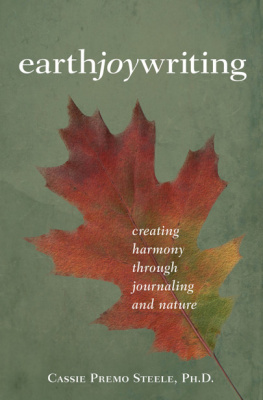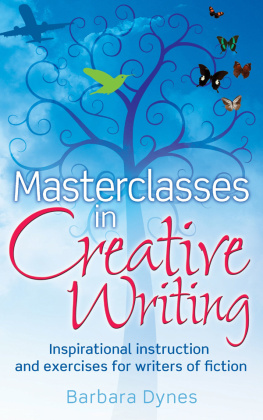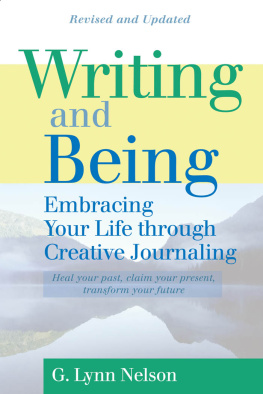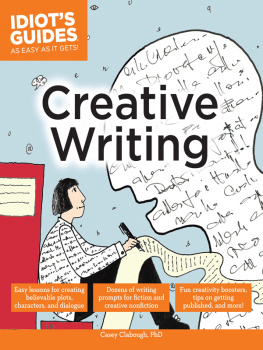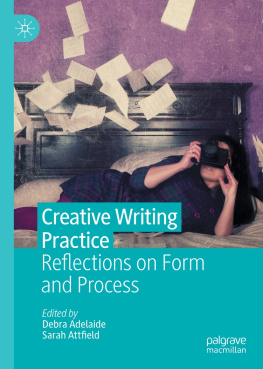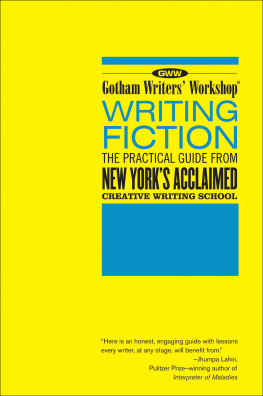Acknowledgments
The first thanks goes to the Earth.
After that, I thank Sunita Dhurandhar, who made a creative pact with me in 2008 that we would write something once a week and send it to each other for encouragement and feedback. When I finished the book, I dreamed that I was standing in the doorway of my studio and saw a huge, pink, full moon in the north saying to me, You are better than this. It was Sunita who told me it would take me years to understand the meaning of this dreamand where the moon was in that vision is where I live now.
I also want to thank all the creative people Ive met in South Carolinapeople who attended the Earth Joy Writing classes and workshops I taught at my studio and at Saluda Shoals Park and those who continue to help me co-create with writing, nature, laughter, and friendship: Amy L. Alley, Lori Baker, Jodi Barnes, Alison Beard, Al Black, Dara Brown, Candace Chellew-Hodge, Grace Contreras, Marie Curry, Lan Ngoc Hoang, Pamela Jacobs, Ellen Kline McLeod, Sandy Spears, Jan Smoak, Debbie and Kendal Turner, Brandi Perry, and Melissa Seligman.
Thanks to David Whiteman, who, as director of the Green Quad Learning Center for Sustainable Futures at the University of South Carolina, hired me to teach the ecopoetry classes that became the seeds for this book. And thanks to my students who shared the joy of writing there with me.
Thank you to Cathy Carter-Scott and Karen Deaton for arranging the Earth Joy Writing workshops I led for many seasons at Saluda Shoals Park.
Deep thanks to Ashley Kaufman, my Ash Tree whose letters through the years have kept me balanced in both hawk flight and bluebird landing.
And I am thankful to my longtime friends, Jemme Stewart and Javier Solano, who have guided me through some of lifes storms and have always believed in me.
Gratitude to Joy Harjo, whose poemsongs accompanied me during walks at dawn.
Love and heartfelt thanks to my daughter, Lily, and my stepdaughter, Laura, for your teachings in how to mother strong daughters so I could understand the feelings of a mothering Earth.
Gratitude to my mother, Blanche Premo-Hopkins, and my father, E. Robert Premo, whose unconditional love helped me grow. And top of the world looking down on creation gratitude to my sister, Bianca Premo.
Earlier versions of Open Your Heart, Tend to the Smallest Wing, and Walk in Truth were published in SageWoman Magazine, Issue 78 (Spring 2010). An earlier version of Pond Lesson appeared in Undefined Magazine , Book Five (MarchApril 2010).
I feel very grateful to Midge Raymond and John Yunker, the co-founders and editors of Ashland Creek Press, for the patient beauty of our work together.
And finally, immense love and thanks to Susanne Kappler, under whose faithful care my body and soul blossom.
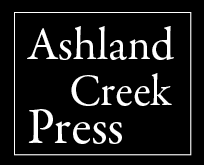
Ashland Creek Press is a small, independent publisher of books with a world view. From travel narratives to eco-literature, our mission is to publish a range of books that foster an appreciation for worlds outside our own, for nature and the animal kingdom, for the creative process, and for the ways in which we all connect. To keep up-to-date on new and forthcoming works, subscribe to our free newsletter by visiting www.AshlandCreekPress.com .
About the Author
Photo credit: Susanne Kappler
Cassie Premo Steele, Ph.D., is the author of twelve books and audio programs on the themes of creativity, healing, and our connection to the natural world. She works as a writing coach with clients internationally. An inspiring and nurturing leader, she guides people to live in ways that are connected to whats important to themcreativity, nature, community, family, and joy.
September
Open to Fear
For many people, September recalls a time of trauma that reverberated for years around the globe. Many of us have healed from individual and collective traumatic histories in our lives.
Before healing happens, however, you are in the dark. You live in a perpetual night, and you are terrified. You try to run. You try to hide. You try to make sense of what happened. But you know deep down that it doesnt really matter what happened. Because at some level you have felt this fear deep inside yourself for much of your life.
And then it comes again. And this time, you decide to confront it. Look it square in the face. Talk back to it. Yell if you need to. Teach your terror words, as you would with a toddler in a tantrum, to express their feelings.
In opening to fear, you learn to take care of yourself. Learn that pushing and doing what you want whenever you want to do it, no matter how fun or exciting it might be, is not a good idea. You learn to find your balance. You learn to find your rhythm. Learn to take the medicine. Learn to make your own medicine.
And then you relax. The fear might still be out there. She still has her territory, and if you try to take it, she will still terrify you. But if you learn to keep good boundaries, roam your own territory, and be yourself, she will leave you alone. The fear will leave you be. Be human.
In the following practices, we will walk through the territory of our fear and come out on the other side. Free.
- Remember this
What used to scare you as a child? What happened that time that terrified you? Choose one of these questions to write about in your journal or on separate sheets of paper in the following way. You may want to do this exercise in the presence of a trusted therapist or coach.
First, spend ten minutes writing about what happened. Who? What? When? Where? Think of yourself as a journalist. Get down the facts. Tell the story.
Time yourself so you feel safe and have boundaries around what you are doing.
When ten minutes are up, switch to a new page and write about how you felt. Pour out all the feelings. The anger, the fear, the sadness, the numbness, the anxiety.
Again, time yourself so you can safely go into these feelings and come back out again. In opening yourself to writing in this balanced way, you are using your hands and your heart and your mind and your memory to create the key that will heal your fear and unlock your own cage.
Be Back in Balance
It is commonplace in our culture to believe that in trauma and loss is the possibility of gain. This philosophy exists in American ideology and in Christian theology and even in our deepest understandings of how history works. It is so deep in us that we often dont recognize it. People say, One door closes and another opens. And, Everything happens for a reason. Or, Its all for the best. And, finally, Hes in a better place.
But trying to cash out loss in this way allows violence to continue.
Think about this question: If traumatic violence results in loss, and this loss ends up making things better in the end, why would we ever want to stop the violence?
Lets look at this in everyday terms. Heres a quiz:
- A friend hurts your feelings. Do you:
- tell her and ask for an apology?
- say nothing and stew in hurt and anger?
- Someone you love dies. Do you:
- keep feelings locked inside and keep going?
- let yourself cry?
- A major catastrophe happens far away. Do you:
- watch it on TV, cry, and feel extreme sorrow?
- send in money for relief efforts?
- You lose your job. Do you:
- become enraged and want to sue your former employer?

